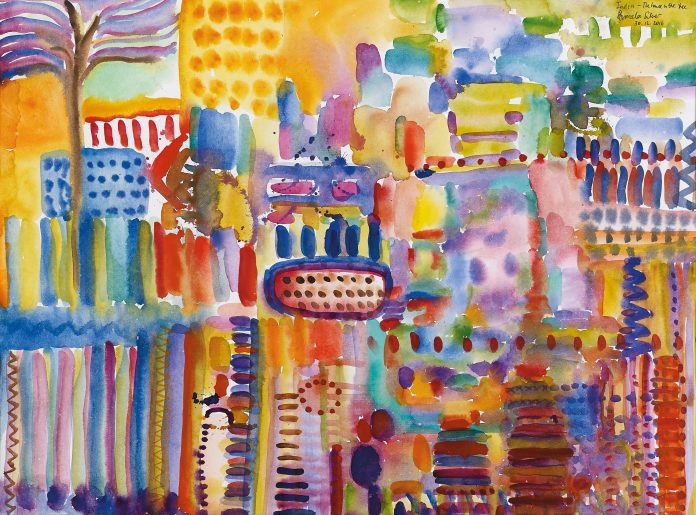By Jaime Uranovsky
Pamela Silver’s latest exhibition, titled, The Colour of Light, is aptly named.
One does not need to spend much time regarding her vibrant watercolours, etchings and monotypes before beginning to absorb their exuberant energy oneself. Although the world-renowned artist (with more than twenty-five solo exhibitions and various awards under her easel) needs little introduction, the perfect one was provided by Professor Deborah Posel, who opened the exhibition on 3 February at the UCT Irma Stern Art Museum.
Research and preparation
Posel, a prominent sociologist and historian at UCT, said that the planning for the exhibition had begun two to three years ago, which is when she started researching the artist. ‘I didn’t know Pam or her work, so I Googled her and what presented itself was a rush of sheer joy, celebrating life, colour and pattern; images that made me smile.’
She used a parable to describe Silver’s attitudes towards her work and towards life, and to illustrate Silver’s nature: that of finding a silver lining in the direst of times; that of seeking the colour of light. Of this nature, Posel said that she was ‘persuaded by flowers in Vilnius. They come from the Ponary Forest, outside Vilnius. The forest shrieks silently about a silent past: Jews taken to death.’ Here, she refers to the massacre of up to 100 000 (mostly Jewish) people in this Lithuanian forest during the Holocaust.
Posel drew attention to the different ways in which she and Silver experienced the Ponary Forest, which they have both happened to visit on separate occasions. ‘We visited at similar times; both in summer. I didn’t see any flowers but Pamela did. She took the seeds, planted them and painted them. This is a parable of an artist who has a gift of finding the flowers both literally and metaphorically. Flowers feature in much of her artwork, but they are not decorative. [They] perform a different kind of symbolic work [and] can be traced through [it]: a geography of flowers of her journey between places, between past and present. The figure of flowers as a juncture between the conscious and subconscious; an elixir of memory; wistful, calmer, slower.’
Art therapy
Indeed, Silver’s pieces are so full of life, that one cannot help but feel uplifted, more jubilant, when met with this medley of colour. The patrons of the exhibition opening were of similar minds. Flavia Orman said, ‘I love the sense of quirkiness. Looking at these pieces feels like art therapy.’
Leeroy Cowie added, ‘This is some of the best merging of colour I’ve ever seen.’
South African ties
Certainly, this year’s exhibition is not Silver’s first time in Cape Town. She was born in Johannesburg, moved to Bulawayo as a little girl and emigrated to Israel when she was twenty-five. Indeed, her family’s history has been tied to South Africa and the country’s Jewish community since the late 19th century: ‘My granny came here, left Vilna, in 1880. She went to the South West and then to Stellenbosch and Cape Town. She was the head of the Bnoth Zion during WWII, and was the chairlady for Aliyah Youth. She would meet youths who were making Aliyah at the airport, as well as meet children who were coming out of the camps.’
Family history
This is not her only familial tie to the country: ‘My grandfather, Leon Segal, came from Bialystok at age 10. He worked at the Cape Times and later had a men’s outfitting shop in Lakeside. Then, he co-founded Ackerman’s with Raymond Ackerman in Wynberg. A Communal leader, he was also the head of the Zionist Federation and the Jewish Board of Deputies.’ The good-doing of her grandparents was clearly passed down to the generations beyond. An example is Silver’s uncle, the late Ronald Segal — the celebrated anti-apartheid activist — who famously smuggled Oliver Tambo over the Botswana border (then British Bechuanaland) in the boot of his car in 1960.
The artist at work
While Silver comes from a line of inspirational individuals whose acts seem tough to follow, she has made her own multi-coloured marks on the world. Christopher Peter, the Director of the Irma Stern Art Museum notes, ‘She’d the kind of artist who is so in touch and on the go; she just electrifies us all. Such camaraderie. We love talking about the past. We are all childhood people.’
Memories and water
Memory and the past are key elements of Silver’s work, which complements and perhaps explains her choice of media (watercolours and monotypes) for this exhibition. She enjoys the instantaneousness of these water-involved forms of media.
Silver explains that the works are ‘created in one moment in time; you can’t make a mistake. It’s a huge surge of energy that is released all at once. It takes immense concentration, so I collect all the energy and then just go for it.’ Silver’s history of swimming might also have played a part: ‘I was a swimmer; I would spend two to three hours a day swimming. So maybe I understand water,’ she laughs. Well, one thing is for sure, Silver certainly understands colour and the expression of it in conjuring joyful emotion — even when it doesn’t seem possible.
The Colour of Light runs until 24 February at the UCT Irma Stern Art Museum. Walkabouts will be held on the 17th and 24th of the month. For more details, contact 021 685 5686 or visit www.irmasternmuseum.co.za.











